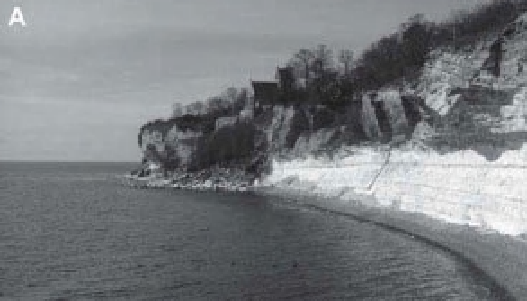Geoscience Reference
In-Depth Information
Figure 8-18.
Højerup Gamle Kirke (old church) on the edge of Stevns Klint, south of Copenhagen, eastern
Denmark. The church was built in 1250-1300 a good distance from the cliff. Erosion of chalk at the base of the
cliff has undermined the more resistant upper layer of limestone, and a landslide in 1928 brought down a portion
of the church building. A. Overview of cliff and remaining church building. Note riprap placed at base of cliff to
prevent further erosion below the church. B. Close-up view of remaining tower and nave of church; the choir and
apse fell down in the landslide. Photos by J.S. Aber.
by one meter, and perhaps even two meters
according to various projections (Church and
White 2006; Pilkey and Young 2009). This eus-
tatic rise will be tempered by local crustal move-
ments, shoreline erosion and deposition, and
other factors, such that some regions will expe-
rience little change in relative sea level, while
others will suffer large increases of several
meters. These scenarios are based on current
rates and trends, which show no signs of slowing
or reversing and may, in fact, accelerate. A sea-
level rise of just one meter would cause immense
damage to human coastal structures, displace
millions of people, and threaten the survival of
coastal ecosystems, particularly wetlands, many
of which are already under assault from human
activities.
Figure 8-19.
Cape Hatteras Lighthouse on the Outer
Banks, North Carolina, United States. Seen here
following l ooding caused by Hurricane Isabel in
September 2003. The original lighthouse location is the
circular sand pad in the foreground. Adapted from
original photo by M. Wolfe; obtained from Wikimedia
Commons
<
http://commons.wikimedia.org/
>
.
before waves threatened to topple it during a
storm in 1980. Following a long and bitter
debate, the National Park Service reached a
decision to move the lighthouse 500 m back
from the shore, which would both preserve the
structure and allow natural coastal processes to
continue. The move was accomplished in 1999
(Fig. 8-19). The present location should be safe
for another century (National Park Service Cape
Hatteras 2010).
During the twenty-i rst century, eustatic sea
level is likely to rise by at least 30 cm, perhaps
8.4 Climate change
8.4.1 Climate basics
The water supply in most wetlands is a delicate
balance between gains and losses, which are
controlled to a considerable extent by climate.
The idea that climate is constant is simply
wrong; climate varies continually in response to
events on Earth as well as extraterrestrial inl u-
ences. The time scales of climatic change range
from decadal variations to shifts over millions








